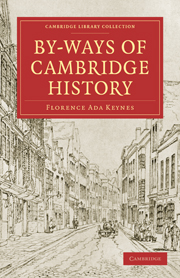Book contents
- Frontmatter
- PREFACE
- Contents
- ILLUSTRATIONS
- Introductory
- Chap. I The Guildhall and the Market Place
- Chap. II The Office of High Steward of the Borough of Cambridge
- Chap. III Cambridge Waits and Orlando Gibbons
- Chap. IV Barnwell Priory and the Old Abbey House
- Chap. V Why Oxford comes First. A Problem in Precedence
- Chap. VI Damaris Cudworth.—A Cambridge Woman of the Seventeenth Century
- Chap. VII A Town Plan for Cambridge in the Eighteenth Century
- Chap. VIII Mendicity House. Sidelights on Social Conditions in Cambridge in the Nineteenth Century
- Appendix: ‘Cambridge’ as a place-name
- Index
- Plate section
Chap. VII - A Town Plan for Cambridge in the Eighteenth Century
Published online by Cambridge University Press: 07 September 2010
- Frontmatter
- PREFACE
- Contents
- ILLUSTRATIONS
- Introductory
- Chap. I The Guildhall and the Market Place
- Chap. II The Office of High Steward of the Borough of Cambridge
- Chap. III Cambridge Waits and Orlando Gibbons
- Chap. IV Barnwell Priory and the Old Abbey House
- Chap. V Why Oxford comes First. A Problem in Precedence
- Chap. VI Damaris Cudworth.—A Cambridge Woman of the Seventeenth Century
- Chap. VII A Town Plan for Cambridge in the Eighteenth Century
- Chap. VIII Mendicity House. Sidelights on Social Conditions in Cambridge in the Nineteenth Century
- Appendix: ‘Cambridge’ as a place-name
- Index
- Plate section
Summary
TOWN-PLANNING in Cambridge is nothing new, nor the need for it. In the British Museum, bound up with a number of old views of the Town, is a manuscript sketch-plan made early in the eighteenth century. This plan was the work of Nicholas Hawksmoor, a pupil of Sir Christopher Wren and later his collaborator.
Hawksmoor was born in 1661, and was therefore twenty-nine years younger than Wren. The first work he is known to have undertaken alone in London was the Church of St Anne's, Limehouse, begun in 1712, one of the fifty churches ordered by an Act of Queen Anne to be built in the Metropolitan area. He must, however, by that time have attained a high reputation in his profession, for he was one of the Commissioners appointed to see that the provisions of Queen Anne's Act were carried through, and he himself was responsible for six of the churches, of which Christ Church in Spitalfields, 1723, the latest of the six, has been described to be as fine a building of its date and kind as can be found in Europe. (Queen Anne's scheme was far too ambitious and it was only found practicable to build eight in all.)
Wren and Hawksmoor both did much work in Oxford, while Wren in his young days had done important work in Cambridge, beginning in 1663 with Pembroke College Chapel, famous as the first building known to have been carried out by him, undertaken at the behest of his uncle, Matthew Wren, Bishop of Ely. This was followed a few years later by the Chapel and Gallery of Emmanuel College and Trinity College Library.
- Type
- Chapter
- Information
- By-Ways of Cambridge History , pp. 127 - 134Publisher: Cambridge University PressPrint publication year: 2009First published in: 1947

